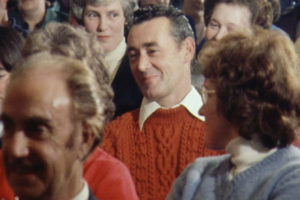Archive

COMPETITION #3 – 70’
08.10.2016 / 19:00
Ledoux
Program 2015 » L’Âge d’Or Prize 2015

Pacho Velez, USA 2014
colour, 10’, DCP, V : ENG, sub : –
Drie kortfilms met archiefbeelden uit de tijd van Ronald Reagans presidentschap, waarmee Pacho Velez de haperingen van de propaganda toont: ceremonies, voorstellingen en interviews van Mr. en Mrs. Reagan die niet volgens plan verliepen.
Trois courts métrages à partir d’images d’archives du couple Nancy et Ronald Reagan pendant les mandats présidentiels de ce dernier, juxtaposés dans le but de mettre à nu les dysfonctionnements d’une forme de « propagande » : cérémonies, présentations et interviews qui ne se déroulent pas comme prévu.
Three short films made of archive footage of Ronald Reagan’s presidency, put together by filmmaker Pacho Velez in order to point out ‘propaganda’ malfunctions: ceremonies, presentations and interviews of the Reagan couple that don’t go as planned.
Kim Kyung-man, South Korea 2014
colour, 10’, DCP, V : KOR, sub : ENG
Beep bestaat uit anticommunistisch filmmateriaal van de jaren 60 tot de jaren 80. Kyungman Kim gebruikt diverse nieuwsfilms, archiefbeelden en ensceneringen die werden besteld of geproduceerd door nationale instellingen in Zuid-Korea. Het belangrijkste geluidselement van Beep komt uit educatief materiaal gepubliceerd door Zuid-Korea’s Ministerie van Opvoeding en Cultuur, dat het verhaal van Lee Seung-bok moest verspreiden, een Zuid-Koreaans kind dat werd vermoord door Noord-Koreaanse soldaten.
Actualités, images d’archive et dramatisations à caractère anti-communiste, des années 1960 aux années 1980, commanditées et produites par des institutions nationales en Corée du Sud. Les principaux éléments sonores du film proviennent de matériaux publiés par le ministère de l’Éducation et de la Culture pour répandre l’histoire de Lee Seung-bok, un enfant assassiné par des soldats nord-coréens.
Beep consists of anti-communist film footage from the 60s through to the 80s. Kyungman Kim uses various newsreels, archival footage and dramatizations that were all commissioned and produced by national institutions in South Korea. The main sound element of Beep is taken from educational material published by the South Korea’s Ministry of Education and Culture to disseminate the story of Lee Seung-bok, a South Korean child known to have been killed by North Korean soldiers.
William Raban, UK 2013
colour, 15’, DCP, V : ENG, sub : –
Time and the Wave focust op Londense evenementen gefilmd in 2012 en 2013: de opening van het Westfield Shopping Centre in Stratford, de Saint Paul’s Occupybeweging, de parade op de Thames naar aanleiding van het jubileum van de koningin en de begrafenis van Margaret Thatcher, om de toestand van Groot-Brittanië te belichten tijdens de crisis van het huidige kapitalisme.
Time and the Wave s’intéresse à certains événements clés qui se sont déroulés à Londres entre 2012 et 2013 : l’ouverture d’un centre commercial, l’occupation de la cathédrale Saint-Paul, la parade navale du Queen’s Jubilee sur la Tamise, et l’enterrement de Margaret Thatcher, afin d’exposer la condition de la Grande-Bretagne en période de crise du capitalisme.
Time and the Wave focuses on key London events filmed in 2012 and 2013: the opening of Westfield Shopping Centre at Stratford, the Saint Paul’s Occupy movement, the Queen’s Jubilee Thames pageant and the funeral of Margaret Thatcher to expose the condition of Britain in the crisis of late capitalism.
Luke Fowler, UK 2014
colour, 25’, Digital file, V : ENG, sub : –
“De films van Luke Fowler staan stil bij het potentiële: wat zou kunnen zijn, wat had kunnen zijn, wat zou misschien blijven, moest de wereld in een andere richting draaien? Maar de film tijd gaat vele richtingen uit, net als argumenten dat doen. Pas gemaakte film kan makkelijk verward worden met archief-vintage van vervaagde of verzadigde tinten en vage randen. Slechts de scheiding tussen geluiden die dicht bij het oor leven en rijke stemmen uit een vervagend verleden onderscheiden archief van heden. Geleidelijk komen de stukken samen: onze nostalgie naar oude volksgebruiken, traditionele zang en de romantiek van de vrijheid, allemaal ondergraven door wetenschappelijk rationalisme en de druk van de wet die normativiteit brengt, uitgeoefend op levens die bestand zijn tegen conformiteit. Wat is een archief, zo niet een verzameling van brieven aan onszelf?” (David Toop)
« Les films de Luke Fowler reposent sur la potentialité : ce qui peut être, ce qui aurait pu être, ce qui pourrait toujours être si le monde tournait autrement. Mais la temporalité du film part dans de nombreuses directions, comme le font les discussions. Des images tournées récemment se confondent avec des images d’archives, pâlies, saturées ou aux contours flous. Seule la distinction entre des sons proches, vivant à l’intérieur même de l’oreille, et de riches voix venues d’un passé qui s’estompe, distingue l’archive du présent. Graduellement, les pièces convergent : notre nostalgie pour les traditions populaires, les chansons folkloriques et la romance de la liberté, toutes minées par le rationalisme scientifique et les pressions de la norme, faisant loi sur les vies ne se pliant pas à la conformité. Qu’est-ce qu’une archive sinon une collection de lettres adressée à nous-mêmes ? » (David Toop)
“Luke Fowler’s films dwell on potentiality: what might be, what might have been, what might still be if the world were to turn in a different direction? But film time runs in many directions, as do arguments. Film made only recently can be easily confused with the archival vintage of washed-out or saturated tones and blurred edges. Only the disjunction between sounds that live close within the ear and rich voices from a fading past distinguish archive from present. Gradually the pieces converge: our nostalgia for ancient folkways, traditional song and the romance of freedom, all undercut by scientific rationalism and the pressures of normativity bringing law to bear on lives resistant to conformity. What is an archive if not a collection of letters to ourselves? ” (David Toop)